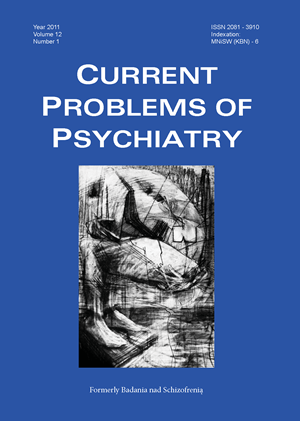Oppositional defiant disorder and conduct disorder in DSM IV
Keywords:
oppositional defiant disorder, conduct disorder, DSM IV TRAbstract
The study discusses the qualification criteria of oppositional defiant disorder and conduct disorders according to DSM IV TR. These disorders occur in the children and adolescents population. The oppositional defiant disorder is manifested as inadequate for a particular age behavior, tenacious, unpleasant, argumentative, rebellious, purposefully irritating, sensitive, revengeful tending to blame others for own offences and negligent conduct. The oppositional defiant disorder usually precedes conduct disorders development; and the conduct behavior encompasses the defiant attitude; however, only up to 25% of children with oppositional defiant disorder in the pre-school age develop the conduct disorders later on. Conduct disorders include various forms of destructive behaviors. Genetics, epidemiology of the prevalence of these disorders by gender, differential diagnosis with other disorders of the developmental age, including ADHD, have been researched and discussed. Dynamics and clinical picture of the disorders along with the development of the child, have been investigated. It was discovered that the patterns of disruptive behaviors come up as a result of combination of neurobiological risk factors, attachment disorders, inadequate parental practices as well as pathological family environment.
References
1. Ebert M.H., Nurcombe B., Loosen P.T., Leckman J.F. Current Diagnosis & Treatment Psychiatry. New York, Chicago, San Francisco, Lisbon, Madrid, Mexico City, Milan, new Delhi, San Juan, Seoul, Singapore, Sydney, Toronto; Mc Graw Hill Medical: 2008.
2. Capi A., Moffitt T.E. The continuity of maladaptive behavior: From description to understanding in the study of antisocial behavior. W: Cicchetti D, Cohen D.J. red., Developmental Psychopathology. Risk, Disorder, and Adaptation. Vol 2. New York; John Wiley & Sons: 1995, s. 472-511
3. Hinshaw S.P., Anderson C.A. Conduct and oppositional defiant disorders. W: Mash E.J., Barkley R.A. red., Child Psychopathology. New York; Guilford Press: 1996, s. 113-152.
4. Lahey B.B., Moffitt T.E., Capi A. Causes of Conduct Disorder and Juvenile Delinquency. New York; Guilford: 2003.
5. Loeber R., Wung P., Keenan K., Giroux B., Stouthamer-Loeber M., Van Kammen W.B., Maugham B. Developmental pathways in disruptive child behavior. Dev. Psychopathol, 1993; 5: 103-133.
6. Bauermeister J.J., Canino G., Bird H. Epidemiology of disruptive behavior disorders. Child Adolesc. Psychiatr. Clin. N. Am., 1994; 3: 177.
7. Loeber R., Keenan K. Interaction between conduct disorder and its comorbid conditions. Clin. Psychol. Rev., 1994; 14: 497.
8. Rogeness G.A.: Biologic findings in conduct disorder. Child Adolesc. Psychiatr. Clin. N. Am., 1994; 3: 271.
9. Jaffee S.R., Caspi A., Moffitt T.E., Dodge K.A., Rutter M., Taylor A., Tully L.A. Nature X nurture: Genetic vulnerabilities interact with physical maltreatment to promote conduct problems. Dev. Psychopathol., 2005; 17: 67-84.
10. Rhee S.H., Waldman I.D. Testing alternative hypotheses regarding the role of development on genetic and environmental influences underlying antisocial behavior. W: Lahey B.B., Moffitt T.E., Caspi A. red., Causes of Conduct Disorder and Delinquency. New York; Guilford: 2003, s. 305-318.
11. Kazdin A., Bass D., Siegel T., Thomas C. Cognitive-behavioral therapy in the treatment of children referred for antisocial behavior. J. Consult. Clin. Psychol., 1989; 57: 522-535.
12. Zavodnick J.M. Pharmacotherapy. In: Sholevar G.P. red., Conduct Disorders in Children and Adolescents. Washington; DC American Psychiatric Press: 1995, s. 269-298.
Downloads
Published
Issue
Section
License
Copyright (c) 2011 Authors

This work is licensed under a Creative Commons Attribution-NonCommercial-NoDerivatives 3.0 Unported License.


